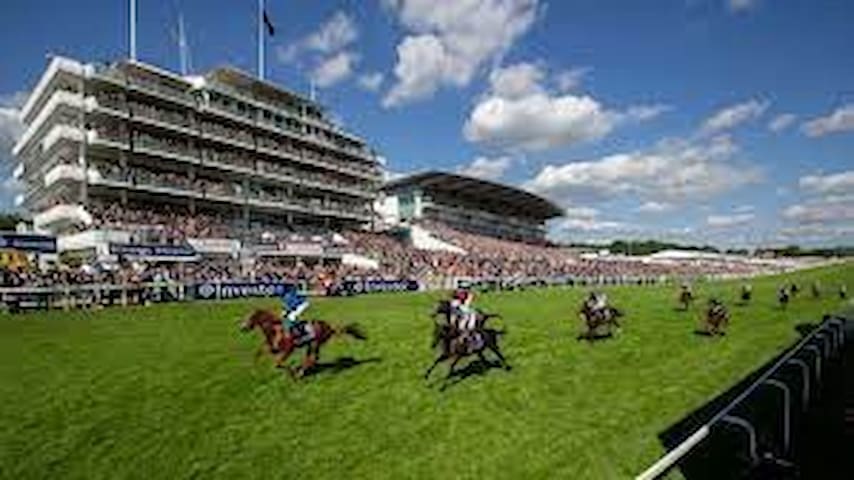Neighbourhoods
Worcester Park
Epsom, or Epsom Downs to give it its full and correct name, is a name synonymous with the sport of horse racing and the Sport of Kings.
Owned by the Jockey Club, it is one of few racecourses in the UK that maintains a fantastic relationship with her Majesty Queen Elizabeth, who attends annually to watch The Derby in early June.
The ‘Downs’ referred to in Epsom Downs’ is part of the North Downs, a ridge of chalk hills that stretch from Farnham in Surrey to the White Cliffs of Dover in Kent. The Epsom Downs overlook the course, and as a public area, people can sit there to watch the races entirely for free.
Including the capacity of the Downs, the racecourse can attract up to 130,000 people per day!
Epsom is not the oldest racecourse in the UK, but its history is rich and varied – perhaps best known as the course where suffragette Emily Davison threw herself in front of King George V’s horse Anmer in protest.
The feel of prestige and rich culture continues to this day, with the course itself proud to present its history and often offering tours.
Unusually, Epsom is a U-shaped track with chutes for the start of races over five, six or seven furlongs.
Today, Epsom is a multi-purpose events venue and used as frequently for music concerts as well it is horse racing.
It also boasts a popular conferencing and business suite, is one of the area’s most popular dog walking spots (post-noon, that is, when the horses finish their training) and an array of Michelin-starred menus and dining and hospitality options for visitors to the course.
Epsom Downs Racecourse History
The first recorded race held at Epsom Downs Racecourse was in 1661, but it’s believed that horse racing was happening in the area much earlier – as burial records from some thirty years before referring to horse racing accidents.
Charles II was a keen fan of racing at Epsom Downs and the course even gets a mention in the diary of Samuel Pepys in 1663. By 1730, a twice-yearly race calendar was established and staff hired.
In 1779, the 12th Earl of Derby, Edward Smith-Stanley, arranged a race to entertain his friends, named The Oaks. The race became so popular that four years later the track was extended to a mile and a half, with Tattenham Corner installed, and The Oaks remains one of Epsom’s most prestigious events today.
In 1913, suffragette Emily Davison infamously threw herself in front of the King’s horse to protest for equal voting rights. She was not instantly killed, but she was severely hurt: and died several days later. She did not live to see her dream of votes for women become a reality less than a decade later.
11 Recomendado por los habitantes de la zona
Epsom
Epsom, or Epsom Downs to give it its full and correct name, is a name synonymous with the sport of horse racing and the Sport of Kings.
Owned by the Jockey Club, it is one of few racecourses in the UK that maintains a fantastic relationship with her Majesty Queen Elizabeth, who attends annually to watch The Derby in early June.
The ‘Downs’ referred to in Epsom Downs’ is part of the North Downs, a ridge of chalk hills that stretch from Farnham in Surrey to the White Cliffs of Dover in Kent. The Epsom Downs overlook the course, and as a public area, people can sit there to watch the races entirely for free.
Including the capacity of the Downs, the racecourse can attract up to 130,000 people per day!
Epsom is not the oldest racecourse in the UK, but its history is rich and varied – perhaps best known as the course where suffragette Emily Davison threw herself in front of King George V’s horse Anmer in protest.
The feel of prestige and rich culture continues to this day, with the course itself proud to present its history and often offering tours.
Unusually, Epsom is a U-shaped track with chutes for the start of races over five, six or seven furlongs.
Today, Epsom is a multi-purpose events venue and used as frequently for music concerts as well it is horse racing.
It also boasts a popular conferencing and business suite, is one of the area’s most popular dog walking spots (post-noon, that is, when the horses finish their training) and an array of Michelin-starred menus and dining and hospitality options for visitors to the course.
Epsom Downs Racecourse History
The first recorded race held at Epsom Downs Racecourse was in 1661, but it’s believed that horse racing was happening in the area much earlier – as burial records from some thirty years before referring to horse racing accidents.
Charles II was a keen fan of racing at Epsom Downs and the course even gets a mention in the diary of Samuel Pepys in 1663. By 1730, a twice-yearly race calendar was established and staff hired.
In 1779, the 12th Earl of Derby, Edward Smith-Stanley, arranged a race to entertain his friends, named The Oaks. The race became so popular that four years later the track was extended to a mile and a half, with Tattenham Corner installed, and The Oaks remains one of Epsom’s most prestigious events today.
In 1913, suffragette Emily Davison infamously threw herself in front of the King’s horse to protest for equal voting rights. She was not instantly killed, but she was severely hurt: and died several days later. She did not live to see her dream of votes for women become a reality less than a decade later.
City/town information
Kingston upon Thames
Sightseeing
The Championships, Wimbledon, commonly known simply as Wimbledon or The Championships, is the oldest tennis tournament in the world and is widely regarded as the most prestigious.
200 Recomendado por los habitantes de la zona
Wimbledon
The Championships, Wimbledon, commonly known simply as Wimbledon or The Championships, is the oldest tennis tournament in the world and is widely regarded as the most prestigious.
Consejos para la ciudad
Facilidad para moverse por la casa
Easy access to the mainline train station and buses.
If you don’t like public transport an Uber's always just a few minutes away...
Costumbres y cultura
Smile and say hello to people...
Most of the time they'll smile and say hello back


